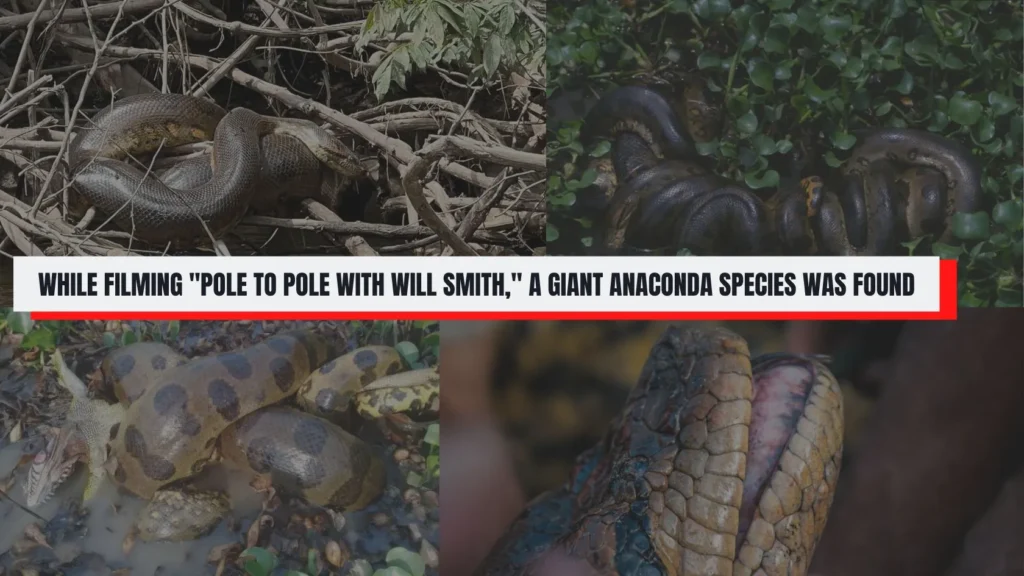Will Smith Documentary Series Filming Update: As you may know, Disney+ is bringing Will Smith‘s new documentary series “Pole to Pole with Will Smith.” A new species of anaconda is found during the filming Pole to Pole with Will Smith.
The series covers a wide-ranging journey spanning different biomes, communities, and landscapes across the Earth.
Will Smith is an American actor and rapper Who has made a special place in the hearts of people with his acting. Some of the films and series starring Will Smith include I Am Legend, Bad Boys 4, Emancipation, etc…
While Filming “Pole to Pole with Will Smith,” a giant anaconda species was Found
Recently, some news has come in that it has been confirmed that during the filming of this docuseries, with the help of the Huaorani people community, a species of anaconda about 10 million years old was discovered, and it is one of the largest species of anaconda ever found.

A team of scientists from the University of Queensland has captured a giant anaconda species deep in the Ecuadorian Amazon while filming the Disney+ series Pole to Pole with Will Smith; it is a National Geographic series streaming on Disney+. Will Smith is the star of the series.
Let us tell you that scientists have discovered this species under the leadership of Professor Brian Fry.
Professor Bryan Fry, in a news release from the University of Queensland Australia, said:-
“The size of these magnificent creatures was incredible,” “One female anaconda we encountered measured an astounding 6.3 meters (20.8 feet) long.”
Professor Brian Fry
Apart from this, Fry told USA Today on February 22:-
“one of only a handful granted since the tribe’s first contact in 1958,”
“Our team received a rare invitation − to explore the region and collect samples from a population of anaconda,”
Chief Baihua also led Fry’s team in the search.
According to Fry the team took canoes down the river in the Bameno area, and Fry added:-
“several anacondas lurking in the shallows, lying in wait for prey,”
Scientist Team collected specimens of the species and named them the northern green anaconda (Eunectes akayama).
Explaining further USA Today, Fry said:-
“The key to understanding the discovery is the difference in the geographic range of anaconda species,”
Amazon has been divided into two different basins, South and North, The southern basin is home to the green anaconda, which includes parts of Brazil, Bolivia, Peru and French Guiana.
While to the north of the Amazon lies a smaller basin that includes parts of Colombia, Ecuador, Guyana, Suriname, Trinidad, Venezuela and French Guiana. Let us tell you that a small basin located in the north of the Amazon is now home to the newly discovered northern green anaconda.
Fry continued his talk by stating that the species of anaconda found in both basins of the Amazon are genetically different by 5.5%. He also added:-
“It’s quite significant – to put it in perspective, humans differ from chimpanzees by only about 2%.”
Sharing further details with TODAY, Fry said:
“There are anecdotal reports from the Huaorani people of other anacondas in the area measuring more than 7.5 meters long (24.6 feet) and weighing around 500 kilograms (1,102 pounds),” They confirmed that they found marks of the same size on Baihua’s son, Marcelo Tepeña Baihua body.
“The scars were clearly from a truly massive snake. They say that one wasn’t even the biggest they’ve ever seen,” “So its clear that the snakes in the Huaorani lands are indeed the biggest of all anaconda.”
Professor Brian Fry says that his team’s work at Amazon is still incomplete, he further said:-
“the delicate fabric of this ecosystem as consequences of the frequent oil spills plaguing the Yasuni Amazon,”
“Our future expeditions will focus on the collection and analysis of soil, water, and biological samples, employing cutting-edge techniques to trace the pathways of these contaminants,”
“By understanding how these metals affect the endocrine systems of the Amazon’s wildlife, we can begin to unravel the long-term consequences of exposure and devise strategies to mitigate these effects.”
The future of new species is uncertain. Fry Continued:-
“I like nothing better than being overheated and under-washed while wading through swamps in search of giant snakes,” said Fry. “This discovery is the highlight of my career.”
The release date for Disney+’s Series Pol To Pol has not been revealed yet. Stay tuned with us.

